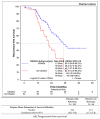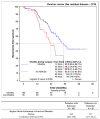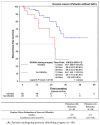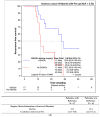Intraoperative Ketorolac and Outcomes after Ovarian Cancer Surgery
- PMID: 38541772
- PMCID: PMC10971204
- DOI: 10.3390/jcm13061546
Intraoperative Ketorolac and Outcomes after Ovarian Cancer Surgery
Abstract
Introduction: Surgery is the cornerstone of ovarian cancer treatment. However, surgery and perioperative inflammation have been described as potentially pro-metastagenic. In various animal models and other human cancers, intraoperative administration of non-steroidal anti-inflammatory drugs (NSAIDs) appears to have a positive impact on patient outcomes.
Materials and methods: In this unicentric retrospective study, we provide an exploratory analysis of the safety and potential benefit of intraoperative administration of ketorolac on the outcome of patients undergoing surgery for ovarian cancer. The study population included all patients who were given a diagnosis of ovarian, fallopian tube or peritoneal cancer by the multidisciplinary oncology committee (MOC) of the Cliniques universitaires Saint-Luc between 2015 and 2020.
Results: We included 166 patients in our analyses, with a median follow-up of 21.8 months. Both progression-free survival and overall survival were superior in patients who received an intraoperative injection of ketorolac (34.4 months of progression-free survival in the ketorolac group versus 21.5 months in the non-ketorolac group (p = 0.002), and median overall survival was not reached in either group but there was significantly higher survival in the ketorolac group (p = 0.004)). We also performed subgroup analyses to minimise bias due to imbalance between groups on factors that could influence patient survival, and the group of patients receiving ketorolac systematically showed a better outcome. Uni- and multivariate analyses confirmed that administration of ketorolac intraoperatively was associated with better progression-free survival (HR = 0.47 on univariate analysis and 0.43 on multivariate analysis, p = 0.003 and 0.023, respectively). In terms of complications, there were no differences between the two groups, either intraoperatively or postoperatively.
Conclusion: Our study has shown a favourable association between the use of ketorolac during surgery and the postoperative progression of ovarian cancer in a group of 166 patients, without any rise in intra- or postoperative complications. These encouraging results point to the need for a prospective study to confirm the benefit of intraoperative administration of ketorolac in ovarian cancer surgery.
Keywords: NSAID; oncological surgery; ovarian cancer; peri operative inflammation.
Conflict of interest statement
None of the authors had conflicts of interest to declare.
Figures








Similar articles
-
Neutrophil:lymphocyte ratio and intraoperative use of ketorolac or diclofenac are prognostic factors in different cohorts of patients undergoing breast, lung, and kidney cancer surgery.Ann Surg Oncol. 2013 Dec;20 Suppl 3:S650-60. doi: 10.1245/s10434-013-3136-x. Epub 2013 Jul 25. Ann Surg Oncol. 2013. PMID: 23884751
-
Intraoperative use of ketorolac or diclofenac is associated with improved disease-free survival and overall survival in conservative breast cancer surgery.Br J Anaesth. 2014 Jul;113 Suppl 1:i82-7. doi: 10.1093/bja/aet464. Epub 2014 Jan 23. Br J Anaesth. 2014. PMID: 24464611
-
Single-dose intravenous ketorolac for acute postoperative pain in adults.Cochrane Database Syst Rev. 2021 May 17;5(5):CD013263. doi: 10.1002/14651858.CD013263.pub2. Cochrane Database Syst Rev. 2021. PMID: 33998669 Free PMC article.
-
A Novel Pharmacologic Activity of Ketorolac for Therapeutic Benefit in Ovarian Cancer Patients.Clin Cancer Res. 2015 Nov 15;21(22):5064-72. doi: 10.1158/1078-0432.CCR-15-0461. Epub 2015 Jun 12. Clin Cancer Res. 2015. PMID: 26071482 Free PMC article. Clinical Trial.
-
Dual Actions of Ketorolac in Metastatic Ovarian Cancer.Cancers (Basel). 2019 Jul 24;11(8):1049. doi: 10.3390/cancers11081049. Cancers (Basel). 2019. PMID: 31344967 Free PMC article. Review.
References
-
- Ledermann J.A., Raja F.A., Fotopoulou C., Gonzalez-Martin A., Colombo N., Sessa C., Group E.G.W. Newly diagnosed and relapsed epithelial ovarian carcinoma: ESMO Clinical Practice Guidelines for diagnosis, treatment and follow-up. Ann. Oncol. 2013;24((Suppl. 6)):vi24–vi32. doi: 10.1093/annonc/mdt333. - DOI - PubMed
LinkOut - more resources
Full Text Sources

